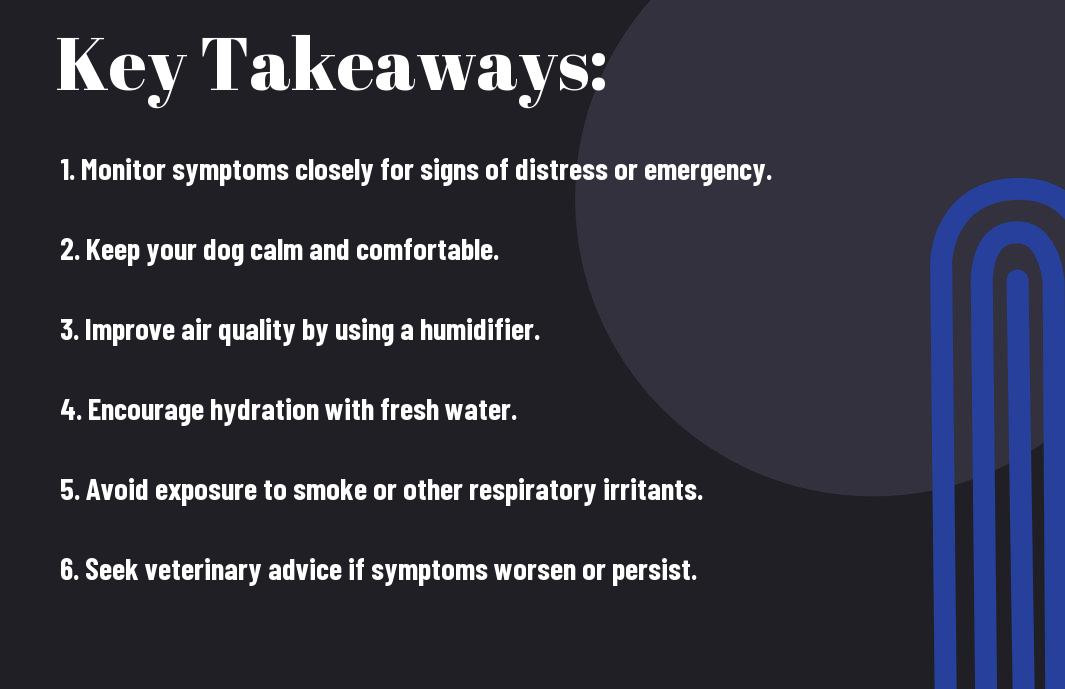Overseeing your furry friend struggling with respiratory distress can be stressful, but knowing how to provide immediate care can make a significant difference. Recognizing the signs of respiratory distress and taking prompt action is crucial in protecting your pet’s health. In this guide, you will learn crucial tips and techniques on how to effectively manage and treat respiratory distress in dogs at home, ensuring your canine companion receives the care they need during such challenging moments.
Key Takeaways:
- Monitor your dog’s breathing: Pay attention to your dog’s respiratory rate and effort, and look out for signs of distress such as coughing, wheezing, or excessive panting.
- Keep your dog calm: Reduce stress and anxiety in your dog by creating a quiet and soothing environment. Avoid exposure to irritants like smoke or strong odors.
- Seek veterinary help: If your dog is showing severe respiratory distress, such as gasping for air or struggling to breathe, it is crucial to seek immediate veterinary care. Do not delay getting professional help in such critical situations.
Identifying Respiratory Distress
Recognizing the Signs and Symptoms
For your furry companion, recognizing the signs and symptoms of respiratory distress is crucial in providing quick care. Watch out for labored breathing, wheezing, coughing, rapid breathing, or even bluish gums or tongue. If your dog is struggling to catch their breath, it’s time to take action.
Common Causes of Respiratory Distress in Dogs
Signs of respiratory distress in dogs can be caused by various factors such as infections, allergies, heart conditions, or even foreign objects stuck in the airway. It’s necessary to pay attention to any recent changes in your dog’s environment or behavior that could be contributing to their breathing difficulties.
Respiratory distress in dogs can be a serious issue that requires immediate attention. If you notice any concerning signs or symptoms, it’s important to monitor your dog closely and seek veterinary care if the symptoms persist or worsen.
Preparing a Safe Environment
It is crucial to create a safe and calm environment for your furry friend when they are experiencing respiratory distress. By removing triggers and stressors, you can help alleviate their symptoms and promote a sense of well-being.
Removing Triggers and Stressors
Any strong scents, smoke, dust, or other airborne particles can worsen your dog’s respiratory distress. Ensure that the air is clean and free of irritants by using an air purifier or keeping windows closed during high pollen or pollution days. Additionally, loud noises or sudden movements can cause stress and anxiety in your dog, making it harder for them to breathe. Keep the environment quiet and peaceful to aid in their recovery.
Creating a Comfortable Space
The creation of a comfortable space is necessary for managing respiratory distress at home. Provide your dog with a quiet and cozy area where they can rest and feel secure. This space should be well-ventilated, free of drafts, and away from any potential hazards that could trigger their symptoms. Placing their favorite blanket or bed in this area can also help them feel more at ease.
This dedicated space allows your dog to relax and focus on their breathing, promoting a sense of calm during this challenging time. Additionally, consider using a humidifier to help ease any congestion and make breathing easier for your furry companion.
Providing Basic Care
To learn more about how to treat respiratory distress in dogs at home, refer to Acute Respiratory Distress in Dogs – Symptoms, Causes …. When your furry friend is experiencing respiratory distress, you can provide basic care at home to help alleviate their symptoms and support their recovery.
Maintaining a Healthy Body Temperature
With respiratory distress, it’s crucial to maintain your dog’s body temperature within a normal range to prevent further complications. Use a thermometer to monitor their temperature regularly. Keep your pup warm with blankets, but avoid overheating them.
| Normal Body Temperature | Between 100.5°F and 102.5°F |
Offering Oxygen Therapy (if necessary)
Temperature
When your dog is struggling to breathe, offering oxygen therapy can be a lifesaving measure. If you have access to an oxygen supply or a humidifier, gently expose your dog to the oxygen to help them breathe easier and improve their oxygen levels.
Offering oxygen therapy should only be done if you are confident in how to administer it safely. Seek guidance from your veterinarian if you are unsure about the process or if you don’t have the necessary equipment.
Administering Medication (if prescribed)
Body
To assist your dog in managing respiratory distress at home, your veterinarian may prescribe medication to reduce inflammation, open airways, or treat underlying causes. Follow the dosage instructions carefully and monitor your pup for any side effects or improvements in their condition.
To ensure the effectiveness of the medication, continue to provide a stress-free environment, plenty of water, and proper nutrition to support your dog’s recovery.
Managing Breathing Difficulties
Once again, it is crucial to address your dog’s respiratory distress promptly to ensure their comfort and well-being. Managing breathing difficulties at home can help alleviate your pet’s distress and aid in their recovery.
Using a Humidifier to Ease Congestion
Ease your dog’s congestion by using a humidifier in the room where they spend most of their time. The added moisture in the air can help loosen mucus in their airways, making it easier for them to breathe. This simple solution can provide relief and comfort to your furry friend during episodes of respiratory distress.
Assisting Breathing with a Nebulizer (if necessary)
Congestion can cause significant discomfort for your dog, impacting their ability to breathe normally. In some cases, using a nebulizer with prescribed medication can help open up their airways and ease breathing. If your dog is struggling with severe respiratory distress, consult your veterinarian for guidance on using a nebulizer at home to support their breathing.
Another vital aspect to consider when assisting your dog’s breathing with a nebulizer is to ensure proper administration of the medication. Follow your veterinarian’s instructions carefully to ensure the effectiveness of the treatment and your pet’s comfort.
Monitoring Respiratory Rate and Effort
Managing your dog’s respiratory rate and effort is imperative in gauging the severity of their condition and tracking their progress. Keep a close eye on how many breaths they take per minute and observe the effort they put into each breath. Any significant changes may indicate the need for immediate veterinary attention.
Nebulizer treatments can be a valuable tool in managing your dog’s respiratory distress at home. When used correctly as directed by your veterinarian, nebulizers can help ease breathing difficulties and promote your pet’s recovery.
Reducing Stress and Anxiety
Providing Calming Aids and Pheromones
After recognizing signs of respiratory distress in your dog, it’s crucial to help reduce their stress and anxiety. Providing calming aids such as pheromone diffusers or sprays can be beneficial. These products mimic natural canine pheromones that have a calming effect on dogs, helping to alleviate anxiety during episodes of respiratory distress.
Minimizing Noise and Distractions
To further reduce your dog’s stress levels during respiratory distress, create a quiet and peaceful environment. Minimize loud noises and distractions that could exacerbate their anxiety. Ensure they have a comfortable, safe space where they can rest undisturbed.
In addition to minimizing noise, consider dimming the lights in the room to create a soothing atmosphere. Providing a sense of calm and serenity can help your dog relax and focus on their breathing, which is crucial during episodes of respiratory distress.
Offering Reassurance and Comfort
Reassurance plays a vital role in comforting your dog during episodes of respiratory distress. Stay close to your furry friend, speak to them in a gentle and reassuring tone, and offer gentle pets and cuddles. Your presence and soothing gestures can help alleviate their anxiety and provide them with the comfort they need to navigate through this challenging time.
Calming music or white noise machines can also be beneficial in creating a relaxed atmosphere for your dog. The soothing sounds can mask external noises and help your dog feel more at ease, promoting a sense of calmness and comfort during episodes of respiratory distress.
Monitoring Progress and Seeking Help
Tracking Vital Signs and Behavior
Noticing changes in your dog’s vital signs and behavior is crucial when managing respiratory distress at home. Keep an eye on your dog’s breathing rate, effort, and any signs of distress such as restlessness, coughing, or wheezing. Monitoring your dog’s temperature and overall behavior can also provide valuable insights into their condition.
Knowing When to Seek Veterinary Care
Seeking veterinary care is crucial if your dog’s respiratory distress worsens or if they show signs of severe distress, such as gasping for air, pale gums, or lethargy. With respiratory issues, it’s better to err on the side of caution and seek professional help promptly to prevent any complications.
With respiratory distress, early intervention can be life-saving, so don’t hesitate to contact your veterinarian if you have any concerns about your dog’s breathing or overall well-being. Timely veterinary care can make a significant difference in the outcome of respiratory conditions.
Monitoring Following Up with Your Veterinarian
Monitoring your dog’s progress after seeking veterinary care is crucial to ensure they are responding well to treatment. Your veterinarian may recommend follow-up appointments, medication adjustments, or additional tests to monitor your dog’s respiratory health. Any updates or changes in your dog’s condition should be communicated to your veterinarian promptly so that they can provide the best possible care.
Following your veterinarian’s instructions and attending scheduled follow-up appointments is crucial for the successful management of respiratory distress in dogs. It’s important to work closely with your vet to ensure your dog’s respiratory issues are properly addressed and monitored.
To wrap up
As a reminder, it is crucial to remain calm and focused when treating respiratory distress in dogs at home. Remember to assess the situation, provide fresh air, and monitor your dog’s condition closely. If the distress persists or worsens, do not hesitate to seek immediate veterinary care. Your quick action and care can make a significant difference in your dog’s health and well-being. Always prioritize your dog’s safety, comfort, and health above all else.
FAQ
Q: What are the common causes of respiratory distress in dogs?
A: Respiratory distress in dogs can be caused by various factors such as infections, allergies, foreign objects stuck in the airways, heart conditions, or even stress and anxiety.
Q: How can I recognize respiratory distress in my dog?
A: Watch out for symptoms like wheezing, coughing, rapid or difficulty breathing, flared nostrils, bluish gums, or exaggerated chest movements, which indicate respiratory distress in dogs.
Q: When should I seek immediate veterinary help for my dog’s respiratory distress?
A: If your dog is experiencing severe respiratory distress, such as gasping for breath, collapsing, or showing signs of extreme distress, it is crucial to seek immediate veterinary assistance.
Q: How can I help a dog with mild respiratory distress at home?
A: Create a calm and quiet environment for your dog, offer fresh water, and gently wipe their nose and mouth with a damp cloth to help them breathe easier. Keep an eye on their symptoms and consult a vet if they worsen.
Q: Can I use a humidifier to help relieve respiratory distress in my dog at home?
A: Yes, using a humidifier in the room where your dog rests can help ease their breathing by moistening the air. However, always consult with your vet before trying any home remedies for respiratory distress.
Are strawberries toxic for dogs
Your Dog’s Allergies: Expert Advice
Demystifying Anal Gland Issues in Dogs: Your Comprehensive Guide from the American Kennel Club




